
Got a flat roof? Here’s what to know about going solar.
Many homeowners assume solar panels only work on sloped roofs, but that’s a common solar myth. In fact, flat roof homes can be well-suited for solar, with benefits like flexible panel placement, easier access, and a low-profile look.
With the right installer and mounting system, a flat roof can support a high-performing solar setup. This guide breaks down everything you need to know — from design and installation considerations, to cost factors, and how to find the right professional for the job.
In this article:
- Are flat roofs good for solar panels?
- Key design considerations for flat-roof solar systems
- Three common mounting options for flat roofs
- Cost factors and installer experience
- Learn more about going solar with a flat roof
- Frequently asked questions
Are flat roofs good for solar panels?
Short answer: Yes, homes with flat roofs can be excellent platforms for solar panels. In roofing, “flat” simply means the roof has a very low slope — or pitch — typically less than 10°, just enough to allow for water drainage. This type of roof is an open canvas for a solar installation, freeing it from the fixed directions of traditional pitched roofs and offering several key advantages:
- Optimal panel orientation: On a pitched roof, panels are locked into the roof’s existing slope (tilt) and direction (azimuth). While installers work within these geometric constraints, a flat roof offers the freedom to orient panels toward the optimal direction — typically true south in the U.S. — which can increase overall energy production.
- Safer, easier access: A flat roof is often walkable, which can make the installation process faster and safer. This also simplifies routine maintenance, like cleanings and inspections.
- Low-profile aesthetics: Because flat-roof panels are mounted at a low tilt and typically set back from the roof’s edge, they’re often less visible from the street. This offers an aesthetic advantage for homeowners who prefer a more discreet look. (Although it’s worth noting that solar panels now look better than ever.)
- Flexible layout: A flat roof provides a more customizable design surface, which is especially helpful for placing panels around vents, skylights, or other rooftop obstructions. Installers can adjust spacing and stagger rows to avoid shading and optimize the placement of every panel.
With the right design and equipment, flat roofs can be a great base for an efficient solar system.
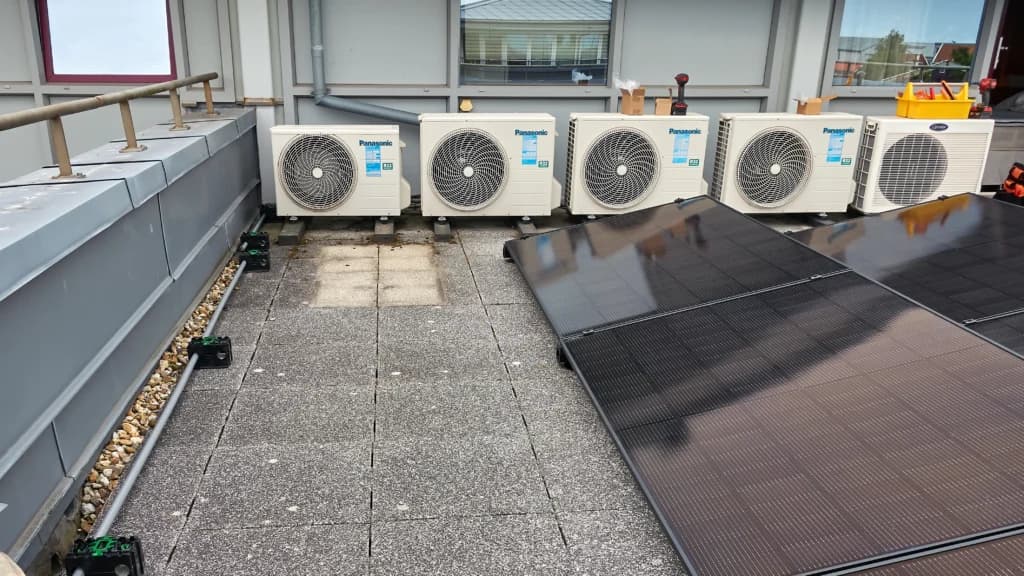
Key design considerations for flat-roof solar systems
A solar installation on a flat roof follows a different set of design rules than one on a pitched roof. Without a natural slope to guide the layout, every detail — from the mounting equipment and panel spacing to water drainage and permitting — must be planned with extra care. While this requires specialized expertise, a well-designed flat-roof system can be just as effective, and sometimes even more flexible, than one on a sloped roof.
Here are the key design considerations to keep in mind:
Panels need to be tilted to capture sunlight efficiently
The sun doesn’t shine straight down — it moves across the sky at a low angle in the morning and evening, and at a steeper angle midday. On a pitched roof, the angle of the roof itself helps the panels face the sun. But on a flat roof, panels are generally tilted up using special frames or tilt kits to receive more direct sunlight throughout the day.
Proper tilt also helps reduce soiling, which is the buildup of dust, pollen, and debris on the surface of the panels. This buildup is more common when panels lie flat and can reduce panel output over time, often requiring more frequent cleaning to maintain performance.
Panels must be spaced to prevent self-shading
On a pitched roof, panels typically follow the slope of the roof and don’t shade each other, so less spacing is needed between their rows. But on a flat roof, panels are elevated at an angle and can cast shadows behind them, especially in the winter, when the sun is lower in the sky.
To avoid self-shading, installers will often space flat-roof panels farther apart and in staggered rows. This also allows water to flow more freely across the roof and leaves access lanes for inspections or future maintenance.
Mounting systems must withstand wind and weather
On a pitched roof, installers drill mounting rails into the roof’s structure and then clamp the solar panels onto them. On a flat roof, installers often use ballasted systems, which rely on heavy weights like concrete blocks to secure panels without drilling, reducing the risk of leaks. However, these systems must be designed to resist “wind uplift,” an effect where the wind blows underneath the panels and lifts them up. For this reason, installers may recommend an attached racking system for flat roof homes in areas with very high winds or heavy snow.
The system must allow for proper water drainage
Because flat roofs don’t shed water as quickly as pitched roofs, panels and mounting equipment must be placed in a way that avoids blocking drains, gutters, or low points where water collects. Installers also have to keep equipment weight evenly distributed to protect the roof’s membrane and underlying structure. A poorly designed system risks water pooling, which can lead to leaks or long-term roof damage.
Permitting rules are often more specific
While all rooftop solar systems must comply with local codes, flat-roof projects typically have more complex permitting constraints. For example, fire safety codes may require more distinct pathways and wider setbacks from the roof’s edge, or limits on panel spacing. Because a flat roof is one continuous surface, these rules are often different from those of a pitched roof, where ridgelines and eaves create natural divisions.
Because every flat roof is a little different, a well-designed system depends on thoughtful decisions about layout and equipment, while being mindful of local permitting rules and climate conditions. An experienced installer can navigate these unique design requirements to ensure your system is both safe and built for long-term performance.
Three common mounting options for flat roofs
As part of designing a solar system for a flat roof, your installer will determine how the panels should be mounted — a decision shaped by factors like your roof’s condition, local climate, and the desired panel tilt. While we briefly introduced mounting strategies earlier, it’s worth understanding the three most common systems in more detail. Each has its own strengths, tradeoffs, and suitability depending on your home’s specific needs.
Ballasted mounts
If you’re concerned about roof penetrations, ballasted mounts are a popular choice. These systems use weight, typically concrete blocks or trays filled with gravel, to secure the solar panel racking without drilling into the roof’s surface. Ballasted setups rest on protective pads or supports that help distribute weight evenly and prevent damage to the roofing membrane.
While ballasted systems are often associated with large commercial roofs, many residential properties can also support them, provided the roof is structurally sound and the system is properly engineered for local wind conditions. Because ballasted systems add considerable weight, an installer will need to assess your roof’s load-bearing capacity before recommending this approach.
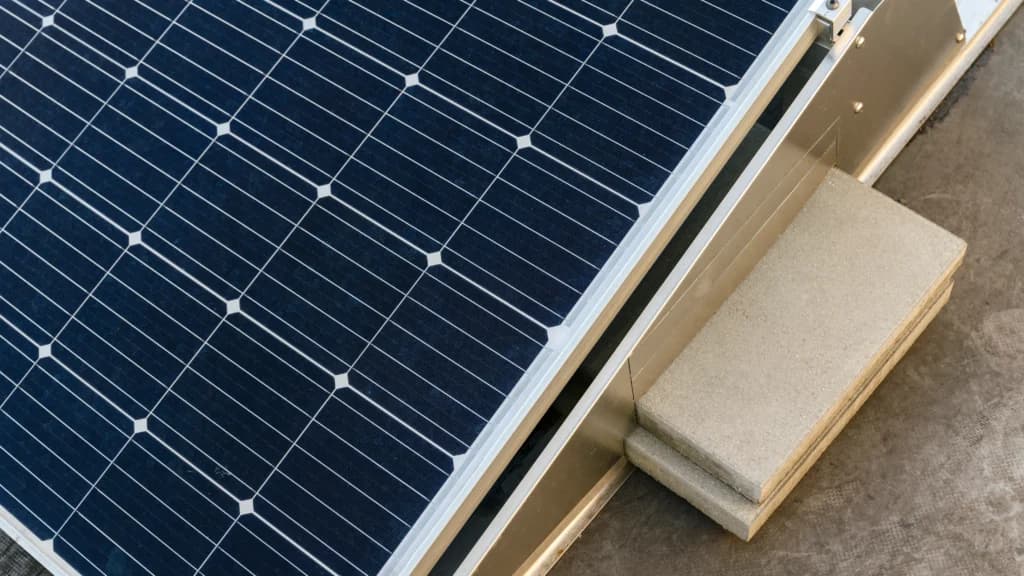
Attached racking systems (rails and clamps)
This method, commonly used on pitched roofs, can also be adapted for flat-roof installations when additional structural anchoring is needed. In this setup, mounting rails are mechanically fastened to the roof’s structural deck, and solar panels are then secured to the rails using clamps. Each roof penetration is carefully sealed and flashed to prevent water intrusion.
On flat roofs, attached racking systems are often used in regions with strong winds, heavy snow loads, or seismic activity — environments where ballasted systems alone may not offer enough long-term stability. These systems may also be combined with tilt frames, or “kits,” to improve solar exposure and reduce soiling. Because attached systems require drilling into the roof, they’re typically recommended only for homes with newer or structurally sound roofs, and always require careful waterproofing by a qualified installer.
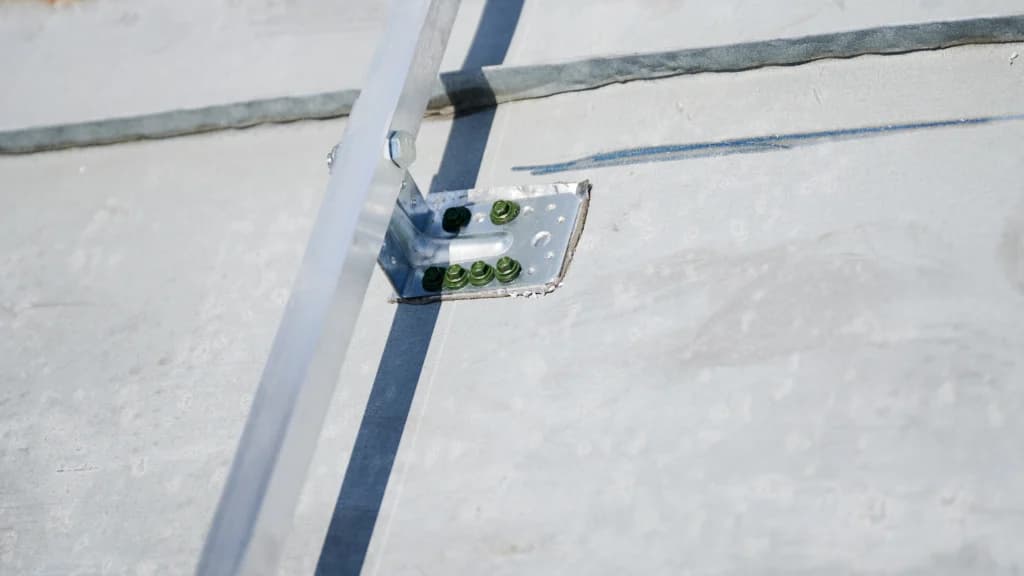
Tilt kits
Tilt kits are metal frames that adjust the angle of your panels, and they’re often used in combination with ballasted or attached racking systems. They’re especially useful on flat roofs because they allow installers to set the panels at a fixed tilt — often aligned with your home’s latitude — so they catch more sunlight and shed debris more effectively than flat-mounted panels.
Some tilt kits are manually adjustable, but most residential systems are set during installation and left in place. In many cases, using tilt kits on a flat roof is the simplest way to improve solar energy performance without dramatically increasing the complexity of the install process.
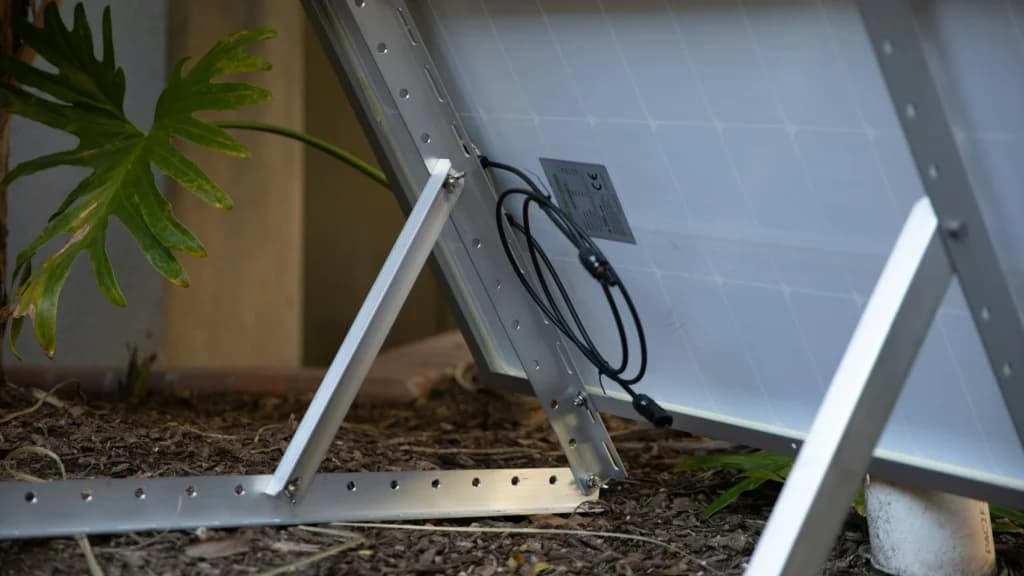
Cost factors and installer experience
Beyond the physical design, a few other factors can influence the overall cost and feasibility of installing solar on a flat roof.
Upfront costs vs. long-term value
Flat roofs can offer easier access for installers — potentially reducing some labor costs — but that benefit is often offset by the need for additional equipment and mounting hardware, structural assessments, and more detailed design planning.
At the same time, flat roofs offer one major advantage: flexibility. Because panels can be tilted and oriented at the ideal angle for sun exposure, they may capture more sunlight than panels mounted on a fixed-slope roof. This increased energy production can lead to greater bill savings over time and deliver excellent long-term value.
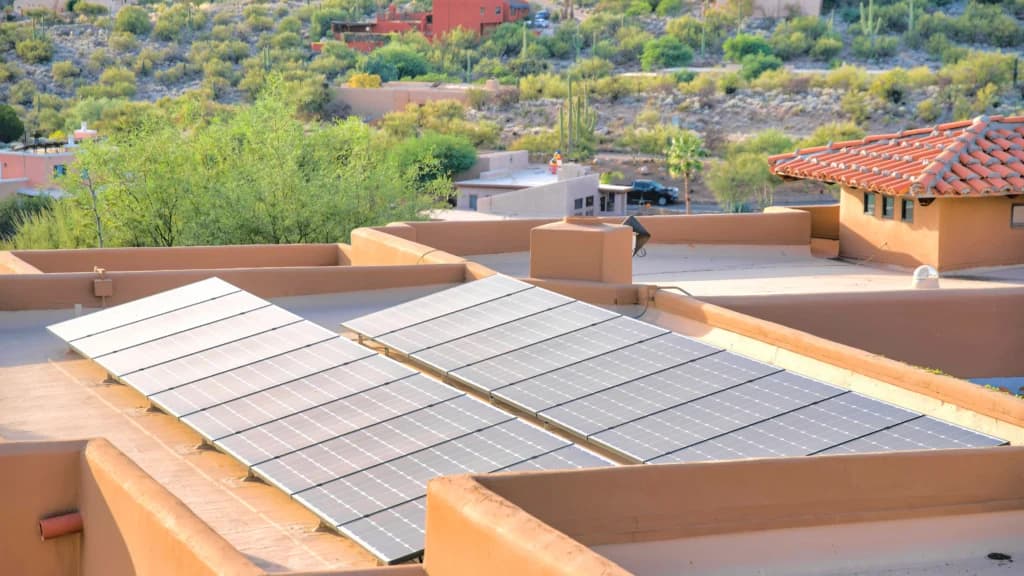
Installer experience may vary by region
Flat roofs are especially common in cities like Washington, D.C., and across the urban Northeast, Midwest, and Southwest. But in areas dominated by pitched-roof suburban homes, not every solar company will have the right equipment or design experience. That’s why it’s important to work with an installer familiar with flat-roof solar systems — including their structural needs, mounting methods, and local permitting rules.
If you are looking for qualified professionals in your area, you can connect with multiple vetted solar installers through Aurora Solar to compare options and view upfront estimates on installation costs and energy bill savings.
Learn more about going solar with a flat roof
A flat roof isn’t a barrier to solar — in fact, it can be an advantage. With the right mounting system and a knowledgeable installer, flat-roof solar systems offer flexibility in layout, optimal panel orientation, and strong long-term performance. Whether you’re looking to maximize energy output or preserve your home’s aesthetics, a well-designed flat-roof system can deliver reliable savings and real value over time.
Frequently asked questions
Can you install solar panels on a flat roof?
Yes — you can install solar panels on a flat roof, and in many cases, it gives you more flexibility than a traditional pitched roof. Since flat roofs don’t have a built-in slope, your installer will use special mounting equipment to tilt the panels for better sunlight exposure and to reduce debris buildup (known as soiling). While it may require different hardware and planning, a flat-roof solar system can be a great option for your home when installed correctly.
Will solar panels on a flat roof perform as well as those on a pitched roof?
Yes — and in some cases, they may perform even better. That’s because you can control how your panels are oriented and tilted, rather than being locked into the angle and direction of your existing roof. With the right setup, your flat-roof system can produce more energy over time, especially if you get a lot of sunlight and have open roof space. Just keep in mind that flat roofs require more careful planning to avoid shading, drainage issues, and wind-related challenges — so installer experience really matters here.
Should I consider a ground-mount or flat-roof solar system?
That depends on your property. Ground-mounted systems offer similar flexibility in tilt and direction, and they’re a good solution if your roof isn’t strong enough for solar or doesn’t get reliable sun exposure. But they also can take up more space, often cost more to install, and are more visible on your property. If your flat roof gets consistent sunlight and is in good condition, it’s usually the more practical and unobtrusive design option, especially in cities or areas with limited yard space.
How are solar panel systems positioned on a flat roof and what’s the best angle?
Your installer will design your panel layout to get the most sunlight throughout the year while protecting your roof and meeting local code requirements. That includes determining the right tilt angle, the direction your panels should face, and how to space them to prevent shading and allow for drainage.
A common rule of thumb is to tilt your panels at an angle close to your home’s latitude and face them toward the equator — which means south for homes in the U.S. This setup helps maximize the amount of sunlight your system receives across all seasons. That said, at higher latitudes (above 45°), your installer may recommend a slightly different angle based on local sun patterns and performance modeling.

